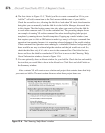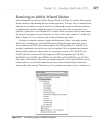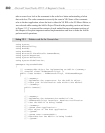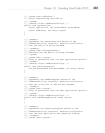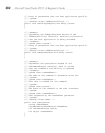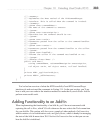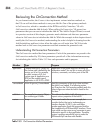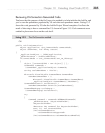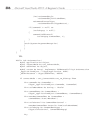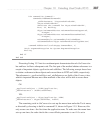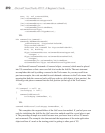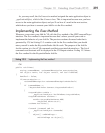
384 Microsoft Visual Studio 2010: A Beginner’s Guide
Reviewing the OnConnection Method
As you learned earlier, the Connect class implements various interface methods so
that VS can call into those methods to run your Add-In. One of the primary methods
is OnConnection, which is a member of the IDTExtensibility2 interface. VS calls
OnConnection when the Add-In loads. When calling OnConnection, VS passes four
parameters that you can use to initialize the Add-In. The Add-In Project Wizard, covered
in a previous section of this chapter, generates much skeleton code that uses parameter
values in OnConnection to initialize the Add-In. While the example in this chapter doesn’t
modify the OnConnection method, understanding the code is helpful in learning how the
Add-In initializes and how it does affect the code you will write later. We’ll first take
another look at OnConnection parameters and then examine the generated code.
Understanding OnConnection Parameters
The OnConnection method has four parameters. Each of the parameters are passed to the
OnConnection method by VS; these parameters provide all of the information necessary
for initializing the Add-In. Table 13-3 lists each parameter and its purpose.
Table 13-3 OnConnection Method Parameters
Member Type Purpose
application Compile-time type is Object, but
the runtime type is defined by the
version you’re at. For example,
on older versions of VS, the
runtime type of Application was
DTE, but the runtime type of
Application in VS 2010 is DTE2.
Application is the parent object for the entire VS
automation model. You use this to access all of the
windows, commands, and other parts of the IDE.
connectMode Enum of type ext_ConnectMode Read this parameter to figure out when and how
the Add-In was loaded. In a following section,
you’ll see how the OnConnection method reads this
value to figure out when the Add-In loads for the
first time.
addInInst The compile-time type is Object,
but runtime type is AddIn.
This refers to the Add-In itself, allowing you to
inspect various properties of the Add-In.
custom Array These aren’t used in the current example, but
consider the fact that we’re implementing an
interface. Besides VS 2010, you could have
another application (host) that supported Add-Ins
that implement the IDTExtensibility2 interface. Those
hosts could use the custom array parameter to pass
information specific to that application. Therefore,
custom is another extensibility point to make the
IDTExtensibility2 interface more flexible.



